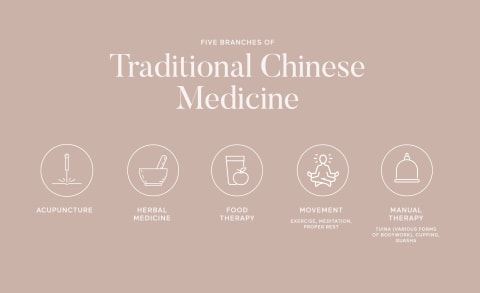The ancient medical text that is still considered the doctrine of Chinese medicine today, The Yellow Emperor’s Inner Classic (黄帝内经), was thought to have been written sometime between 2600 B.C. and 300 B.C1. However, more recent discoveries suggest that the roots of TCM may extend even deeper. In 1991, archaeologists uncovered a well-preserved, 5,000-year-old mummy in Central Europe2 that had acupoints tattooed on the body. Detailed x-rays revealed arthritis in the hips, knees, and lumbar spine of this prehistoric man. Scientists were amazed that his ailment corresponded with the tattooed acupoints, which combined to form a meaningful acupuncture treatment regimen for his conditions. And just this year, researchers discovered an anatomy atlas written in Han Dynasty China over 2,000 years ago—500 years before the Greeks created what has long been considered the first human anatomy map. This important finding has implications on the basis for acupuncture and the history of medicine as we know it. It’s safe to say that the Chinese have been practicing the techniques that are now known collectively as TCM for a long, long time. With its rich history and wide reach, TCM has endured the test of time and become widely practiced outside of Asia in recent years. TCM draws on Taoism philosophy that is rooted in the laws and synergies of nature, and it applies these synergies to the human body. It recognizes that our organ systems are interconnected and our health is dependent on chi. Translated to modern-day language, chi is active energy—a metaphor for metabolic processes taking place in a living being. To be alive is to have vital chi flowing through the body. TCM theory states that when chi is in perfect balance, we enjoy good health. However, internal and external factors such as diet, weather, and pathogens can all create imbalances in chi, which eventually result in disease. In order to maintain balance, TCM further uses the concept of “Yin-Yang energetics” and “5-element theory” to classify disease patterns. Another crucial concept in TCM is the meridian system, which forms the fundamentals of acupuncture. The meridians are the pathways through which chi, blood, and bodily fluids travel in the body. These pathways are not merely the blood vessels or the nerve networks. Together, they create a complete road map of the body and explain how different organs and metabolic functions are interlinked. (Interestingly enough, that recently discovered anatomy reference also mapped out the meridians in detail.) To get a comprehensive picture of the patient’s health, we use five pillars of examination (look, listen, touch, smell, ask), often examining the tongue and reading the pulse during a health intake. These two metrics give us a snapshot of the status of internal organs and meridians. Modalities such as acupuncture, herbs, moxibustion, gua sha, cupping, Tui na, and diet changes can then be prescribed, depending on the patient’s needs. Here’s a quick introduction to these five TCM pillars. Of all five branches of TCM, acupuncture is the one that has been the most progressively integrated into the conventional medical system. The World Health Organization (WHO) now recognizes it as an effective treatment for 28 conditions, including neck and back pain and some allergies. “What is most valuable through this practice is the flexibility for an experienced herbalist to be able to tailor-make the prescription based on the patient’s constitution and symptoms,” says herbalist and acupuncturist Yang Xia R. TCMP. He adds that herbal prescription uses a holistic approach. Compatible herbs create synergy, which can enhance overall efficacy while reducing side effects. Diets are customized to individual body constitutions. For example, a person who has a tendency to have cold extremities and poor circulation will benefit from consuming more warming foods such as pumpkin, scallion, beef, ginger, cinnamon, black pepper etc., whereas a person who is prone to acne and dry mouth would be told to stay away from those same foods. TCM exercises often pair mindful breathing techniques with light movements and meditation. Some traditional examples are Taiji and qigong. In TCM, a balanced lifestyle is active yet restful, so following your circadian rhythm and getting adequate sleep are equally important to this branch. Tui na is one of the most ancient forms of bodywork. It literally translates to “push-and-grasp.” In this practice, the therapist applies pressure along the meridians using various twisting, pulling, turning, pushing, and kneading techniques. The goal is to unblock those pathways, facilitate lymphatic flow or drainage, improve circulation, and stimulate the nervous system. Traditionally, the practice is combined with muscular manipulation and joint mobilization to achieve osteopathic functions. In the past, TCM actually split some of these therapies into their own branches. The eight branches in older forms of TCM are acupuncture, herbal medicine, food therapy, meditation, energetics, tui na, cosmology, and feng shui. Growing up in a family of TCM practitioners, Snow learned from a young age that mind-body wellbeing is the key to radiant beauty. This knowledge has helped her navigate a modeling career spanning two decades; working with esteemed brands like Oscar de la Renta, Rick Owens, Louis Vuitton, and Chanel. After college, she also had a brief career in investment management, where she eventually suffered burnout living a high-stress, high-intensity lifestyle. With the help of acupuncture and herbs, she was able to recover from her ailments and regain balance. Her own healing journey has guided her back to her ancestral roots. It inspired her to dedicate herself to study the ancient science of acupuncture, and to help others restore their health. Since establishing her practice, Snow has successfully helped hundreds of clients reclaim their health. She has been recognized as one of the top acupuncturists in New York City for four consecutive years. It is her passion to help busy New Yorkers take control of their own health while living ambitious lives.



